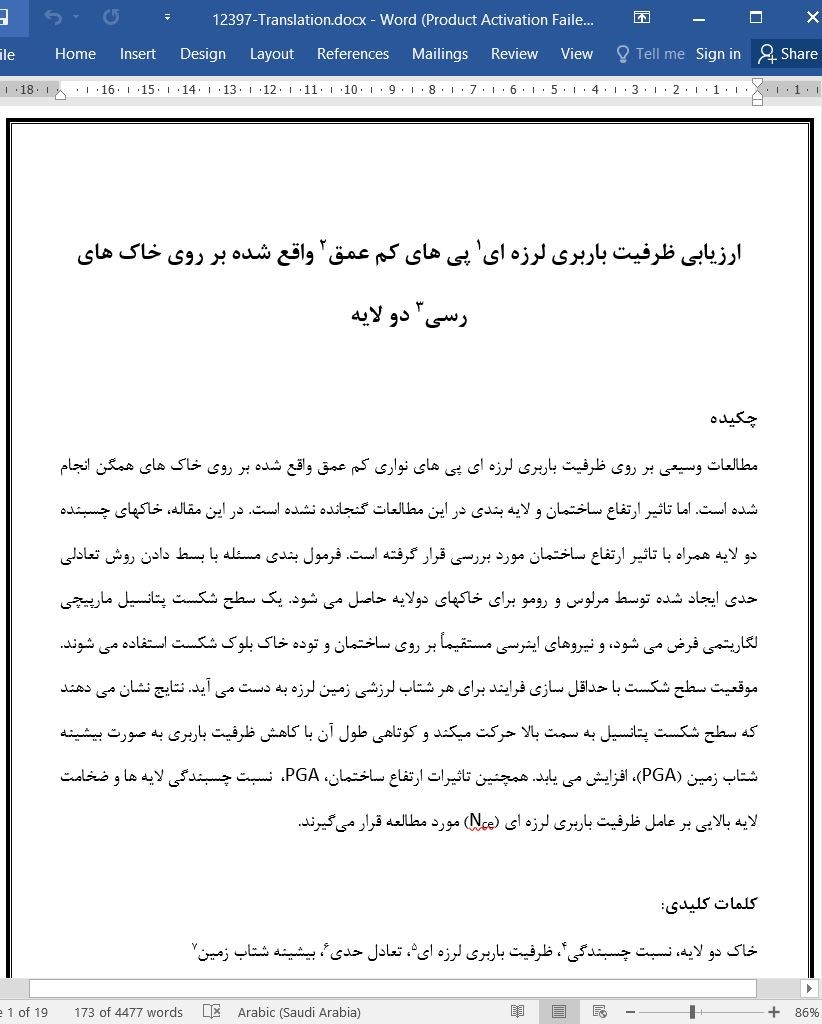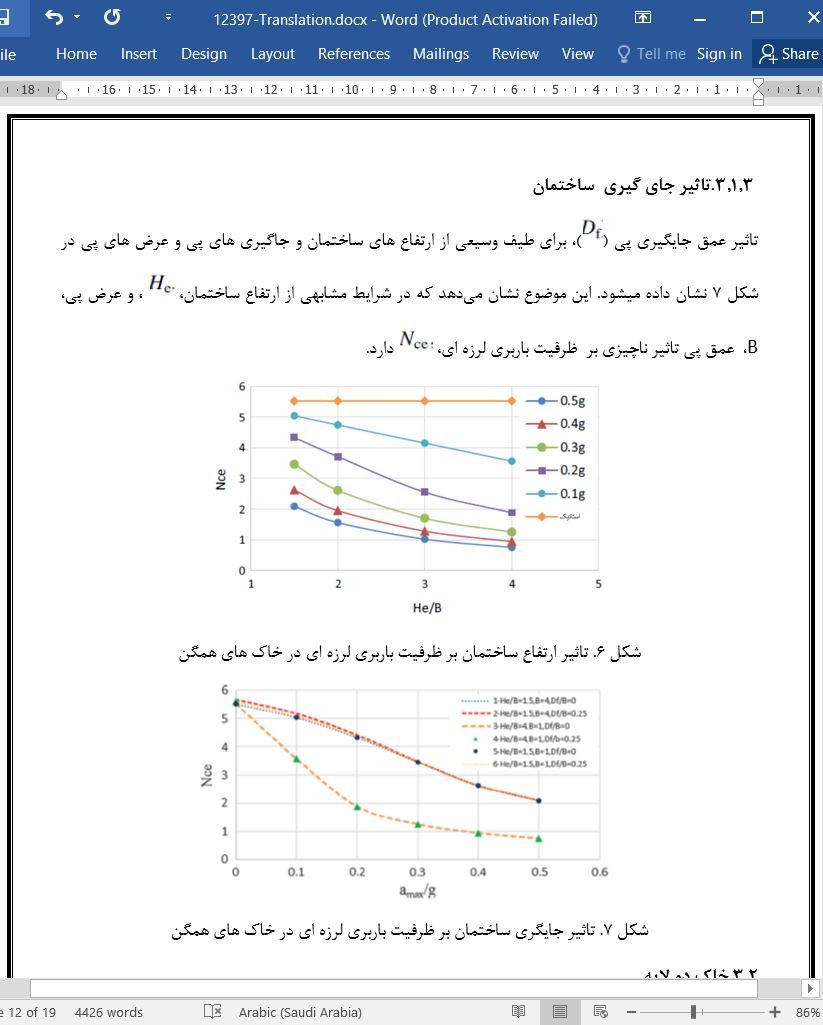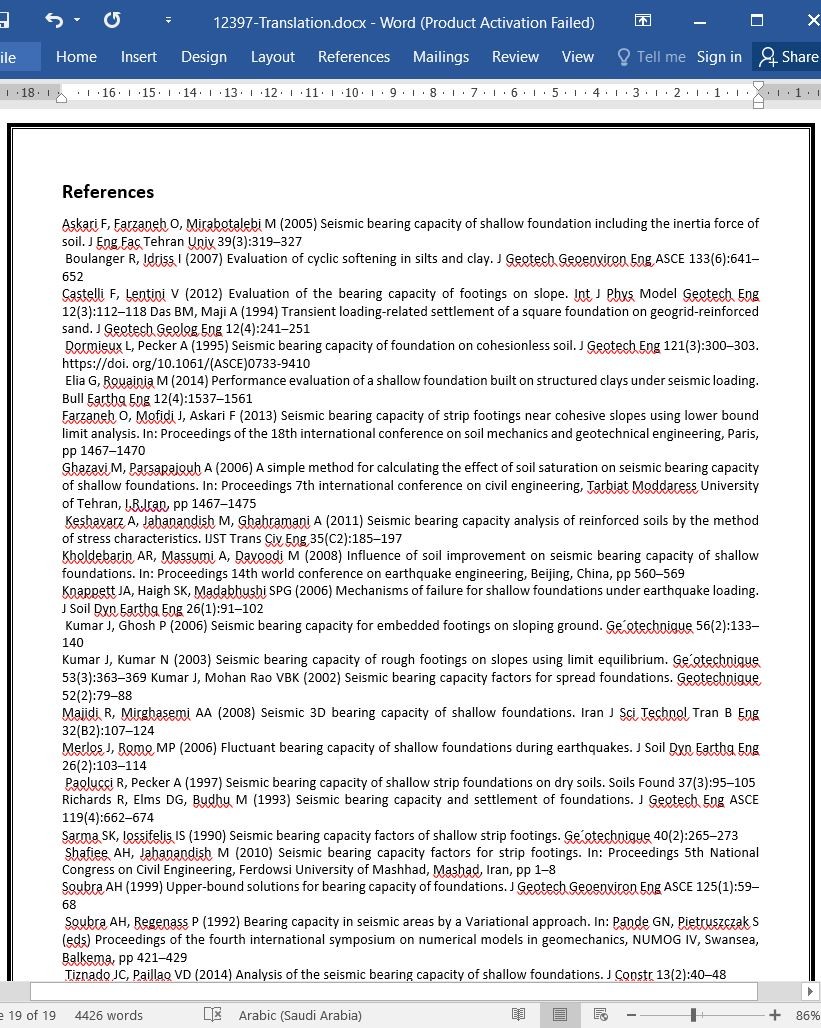
ارزیابی ظرفیت باربری لرزه ای پی های کم عمق واقع شده بر روی خاک های رسی دو لایه
چکیده
مطالعات وسیعی بر روی ظرفیت باربری لرزه ای پی های نواری کم عمق واقع شده بر روی خاک های همگن انجام شده است. اما تاثیر ارتفاع ساختمان و لایه بندی در این مطالعات گنجانده نشده است. در این مقاله، خاکهای چسبنده دو لایه همراه با تاثیر ارتفاع ساختمان مورد بررسی قرار گرفته است. فرمول بندی مسئله با بسط دادن روش تعادلی حدی ایجاد شده توسط مرلوس و رومو برای خاکهای دولایه حاصل می شود. یک سطح شکست پتانسیل مارپیچی لگاریتمی فرض می شود، و نیروهای اینرسی مستقیماً بر روی ساختمان و توده خاک بلوک شکست استفاده می شوند. موقعیت سطح شکست با حداقل سازی فرایند برای هر شتاب لرزشی زمین لرزه به دست می آید. نتایج نشان می دهند که سطح شکست پتانسیل به سمت بالا حرکت میکند و کوتاهی طول آن با کاهش ظرفیت باربری به صورت بیشینه شتاب زمین (PGA)، افزایش می یابد. همچنین تاثیرات ارتفاع ساختمان، PGA، نسبت چسبندگی لایه ها و ضخامت لایه بالایی بر عامل ظرفیت باربری لرزه ای (Nce) مورد مطالعه قرار میگیرند.
1. مقدمه
شدیدترین موقعیت بارگیری یک فونداسیون، تحت تاثیر اتفاقی است که در طول یک زلزله رخ می دهد. بنابراین طراحی پی ها در نواحی لرزه ای در مقایسه با نواحی ثابت به توجه ویژهای نیاز دارند. برخی محققان ظرفیت باربری لرزه ای پی های نواری کم عمق را به صورت تئوری یا تجربی مورد مطالعه قرار داده اند. سه رویکرد اصلی در مطالعات تئوری دنبال می شوند: تحلیل شبه استاتیک، پویا و کاملا پویا. در رویکرد شبه استاتیک، شتاب های افقی و عمودی بر مرکز ثقل سازه یا در سطح پی وارد می شوند و این مشکل با بار های غیر متمرکز در حالت استاتیک ظرفیت باربری، کاهش می یابد. در بیشتر این راه حل ها، اینرسی توده خاک در نظر گرفته نمیشود. در یک رویکرد شبه پویا، فرض می شود که سطح شکست توسعه یافته در طول موقعیت پویا مشابه با سطح شکست توسعه یافته تحت بار استاتیک باشد و معادله حرکت از موقعیت های تعادلی پویا به دست می آید. در این زمینه، تاثیر زلزله بر ایستایی خاک در معادله تعادلی گنجانده می شود. همچنین، توزیع شتاب زلزله نیز در نظر گرفته می شود. رویکرد کاملا پویا با استفاده از روشهای عددی مبتنی بر تحلیل تاریخچه زمانی است.
4. نتیجه گیری
با استفاده از روش تعادل حدی و روش تحلیل شبه استاتیک، تعمیمی از مدل مرلوس و رومو برای در نظر گرفتن تاثیر لایه بندی خاک و نسبت ارتفاع به عرض ساختمان در ظرفیت باربری لرزه ای پی های نواری کم عمق، توسعه می یابد. این موارد در مطالعات قبلی در نظر گرفته نشدند. فرض می شود که این ماده از جنس پلاستیک کاملاً سخت باشد. این مدل در مقایسه با نتایج حاصل از خاک های همگن تایید می شود. همچنین، تاثیرات برخی پارامترهای موثر بر عامل ظرفیت باربری لرزه ای مورد مطالعه قرار می گیرند و با نتایج تجربی مقایسه می شوند. این نتایج تاکید می کنند که ظرفیت باربری به دلیل نیروی افقی زلزله تحت بار لرزه ای کاهش می یابد، که سطح شکست را به سمت بالا هدایت می کند. همچنین این نتایج به وضوح نشان می دهند که موقعیت و اندازه سطح شکست و ایمنی لرزه ای پی ها به بزرگی شتاب توسعه یافته در سراسر رخداد لرزه ای همانند شکل های 7،8 و 9 بستگی دارد.
Abstract
The seismic bearing capacity of shallow strip footings located on homogeneous soils is studied extensively. But the effect of building height and layering is not included in those studies. In this paper two-layered cohesive soils are studied along with building height effect. The formulation of the problem is derived by extending the limit equilibrium method developed by Merlos and Romo (J Soil Dyn Earthq Eng 26(2):103–114, 2006) for two-layered soils. A log-spiral potential failure surface is assumed, and the inertia forces are applied directly to the building and the failure block soil mass. The position of the failure surface is obtained by a minimization process for every earthquake shaking acceleration. Results show that the potential failure surface moves upward and its length shortens as the peak ground acceleration (PGA) increases, reducing the bearing capacity. Also, the effects of building height, PGA, ratio of cohesion of the layers and the thickness of the top layer on seismic bearing capacity factor (Nce) are studied.
1 Introduction
The most severe loading condition a foundation undergoes is what happens during an earthquake. Thus, the design of foundations in seismic areas needs special consideration compared to the static case. Some researchers have studied the seismic bearing capacity of shallow strip footings, either theoretically or experimentally. Three main approaches are followed in theoretical studies: pseudo-static, pseudo-dynamic and full dynamic analysis. In pseudo-static approach, horizontal and vertical accelerations are applied to the center of gravity of the structure or at the foundation level, and the problem is reduced to a static case of bearing capacity with inclined eccentric loads. In most of these solutions, the inertia of the soil mass is not included. In a pseudo-dynamic approach, the failure surface developed during dynamic condition is assumed to be similar to the one under static loading and the equation of motion is derived from the dynamic equilibrium conditions. In this context, the effect of the earthquake on supporting soil is included in the equilibrium equation. Also, the distribution of earthquake acceleration is included. The full dynamic approach is based on time-history analysis using numerical methods.
4 Conclusions
Using the limit equilibrium method and pseudo-static method of analysis, an extension of Merlos and Romo model is developed for considering the effect of soil layering and height-to-width ratio of building on the seismic bearing capacity of shallow strip foundations. These were not considered in earlier studies. The material is assumed to be rigid-perfect-plastic. The model was verified by comparing with the results of homogeneous soils. Also, the effects of some effective parameters on the seismic bearing capacity factor are studied and compared to experimental results. The results emphasize that the bearing capacity is reduced mainly due to the horizontal force of earthquake under seismic loading, which drives the failure surface upward. The results, also, clearly show that the failure surface position and size and the seismic safety of the foundations depend on the acceleration magnitudes developed throughout the seismic event as shown in Figs. 7, 8 and 9.
چکیده
1. مقدمه
2. روش تحلیل
2.1. فرمول بندی مسئله
2.1.1. لنگرهای موثر
2.1.2. لنگرهای مقاوم
2.1.3. خاک دو لایه
2.1.4. ظرفیت باربری لرزه ای
3.نتایج و بحث
3.1. خاک همگن
3.1.1.مقایسه با سایر تحقیقات
3.1.2. تاثیر ارتفاع ساختمان
3.1.3.تاثیر جای گیری ساختمان
3.2.خاک دو لایه
3.2.1.تاثیر ارتفاع ساختمان و PGA
3.2.2.تاثیر نسبت چسبندگی لایه ها
3.2.3. تاثیر ضخامت لایه بالایی
3.2.4. تاثیر جایگیری ساختمان
4. نتیجه گیری
منابع
Abstract
1 Introduction
2 Method of Analysis
2.1 Formulation of the Problem
2.1.1 Driving Moments
2.1.2 Resisting Moments
2.1.3 Two-Layered Soil
2.1.4 Seismic Bearing Capacity
3 Results and Discussion
3.1 The Homogenous Soil
3.1.1 Comparison with Other Researches
3.1.2 The Effect of Building Height
3.1.3 The Effect of Building Embedment
3.2 Two-Layered Soil
3.2.1 The Effect of Building Height and PGA
3.2.2 The Effect of the Ratio of Cohesions of the Layers
3.2.3 The Effect of the Thickness of the Top Layer
3.2.4 The Effect of the Building Embedment
4 Conclusions
References
- ترجمه فارسی مقاله با فرمت ورد (word) با قابلیت ویرایش، بدون آرم سایت ای ترجمه
- ترجمه فارسی مقاله با فرمت pdf، بدون آرم سایت ای ترجمه



